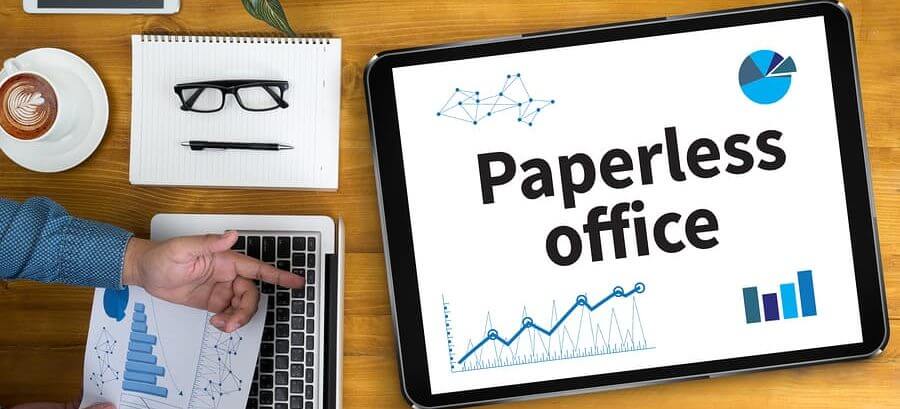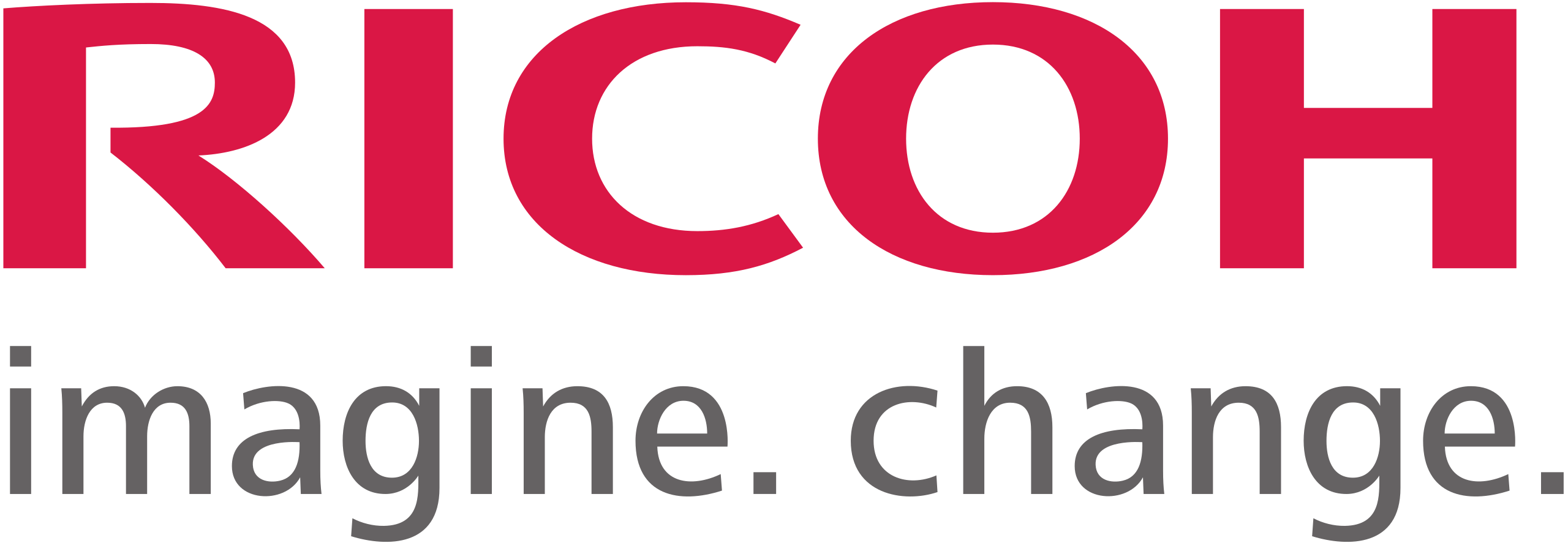11 min read
11 Advantages of Having a Paperless Office
By:
Standley Systems Staff
on
August 5, 2024
Updated: August 30, 2024

The advantages of having a paperless office are numerous and impactful. They transform traditional business operations into sleek, efficient, and environmentally friendly processes. Imagine an office where clutter is a thing of the past, where every document is just a click away, and where your business operations are more efficient and secure. Picture a workspace that embodies modernity and innovation, where employees can collaborate seamlessly from anywhere in the world, and where the environmental footprint of your business is significantly reduced. This isn't a distant dream—it's the reality of a paperless office.
In this blog, we'll explore eleven compelling advantages that make the shift to a paperless environment not only beneficial but also essential for modern businesses. From boosting productivity and cutting costs to enhancing security and promoting sustainability, the advantages of a paperless office are far-reaching and transformative. By understanding and embracing these benefits, businesses can not only improve their operations but also position themselves for success in an increasingly digital and environmentally conscious world. Let's dive into the details of how going paperless can revolutionize your office and set the stage for a more efficient, innovative, and sustainable future.
Understanding the Paperless Office
A paperless office is an environment where the use of paper is minimized or eliminated by converting documents and other paperwork into digital formats. This shift not only helps streamline operations but also brings numerous benefits to businesses and the environment. Digital documents are stored in the cloud or on local servers, accessible with just a few clicks, making information retrieval faster and more efficient. Going paperless involves using various digital tools and technologies, including document management systems (DMS), cloud storage, and digital signatures.

The Purpose of a Paperless Office
The primary purpose of a paperless office is to improve efficiency and productivity by leveraging digital tools and technologies. However, the benefits extend beyond mere convenience, touching upon cost savings, environmental impact, and enhanced security. A paperless office also fosters a modern, innovative image, appealing to clients and partners who value sustainability and forward-thinking practices. By minimizing paper use, businesses can reduce clutter, enhance document security, and contribute to environmental conservation.
The Transition to a Paperless Office
Transitioning to a paperless office involves several steps, including assessing current paper usage, planning the transition, adopting the right technology, and training employees. This transformation requires a strategic approach to ensure a smooth and effective changeover.

Starting with high-impact areas, businesses can gradually expand their paperless practices, making adjustments and improvements along the way. The transition involves:
- Assessment: Evaluate current paper usage and identify areas where digital solutions can replace paper.
- Planning: Develop a detailed plan outlining the steps, timelines, and resources required for the transition.
- Technology Adoption: Invest in the necessary technology, such as scanners, DMS, and cloud storage solutions.
- Training: Train employees on new processes and tools to ensure a smooth transition and adoption.
- Implementation: Start with a pilot project, gather feedback, and gradually expand the paperless practices across the organization.
- Review and Improve: Continuously monitor and improve the processes to maintain efficiency and address any challenges.
Common Challenges in Going Paperless
While the benefits of a paperless office are numerous, the transition can come with its own set of challenges. Understanding these challenges beforehand can help you prepare and develop strategies to overcome them. Common challenges include:
- Resistance to Change: Employees may be accustomed to traditional paper-based workflows and resistant to adopting new digital processes. Overcoming this requires clear communication of the benefits, providing adequate training, and addressing concerns.

- Technical Issues: Implementing new digital systems can come with technical challenges, such as compatibility issues and system downtime. Working with experienced IT professionals can help ensure a smooth implementation.
- Cost of Implementation: The initial cost of transitioning to a paperless office can be high, involving expenses for new hardware, software, and training. However, the long-term cost savings can offset these initial investments.
- Data Security Concerns: Storing sensitive documents digitally can raise concerns about data security and privacy. Implementing robust security measures, such as encryption and multi-factor authentication, can help mitigate these risks.
- Ensuring Consistent Use: Maintaining consistent use of digital tools and adherence to new processes can be challenging. Regular monitoring, ongoing training, and clear guidelines can help ensure consistent use.
Best Practices for Maintaining a Paperless Office
Once you’ve transitioned to a paperless office, it’s essential to implement best practices to ensure the system remains efficient, secure, and effective. Regular backups, consistent training, periodic audits, robust security measures, and efficient document management are key to maintaining a paperless office. Continuous improvement and feedback from employees can further enhance the system. Best practices include:
- Regular Backups: Schedule automatic backups to prevent data loss and ensure quick recovery in case of system failures or cyber-attacks.

- Consistent Training: Provide ongoing training sessions and resources to keep employees proficient in using digital tools and adhering to new workflows.
- Periodic Audits: Conduct regular audits to ensure compliance with industry regulations and identify areas for improvement.
- Security Measures: Implement strong security protocols, such as encryption, access controls, and regular security updates, to protect sensitive digital documents.
- Efficient Document Management: Use clear naming conventions, document retention policies, and advanced search functionalities to keep digital files organized and easily accessible.
1. Enhanced Productivity
One of the most significant benefits of a paperless office is the remarkable boost in productivity. Employees no longer need to spend valuable time searching through filing cabinets or dealing with misplaced documents. Digital document management systems allow for instant access to files, enabling quick retrieval and efficient collaboration. Imagine the time saved when every document is just a few keystrokes away. This efficiency translates into more time spent on strategic tasks, driving the business forward. Moreover, automation of routine tasks, such as invoicing and data entry, can further enhance productivity by reducing manual effort and minimizing errors.
2. Cost Savings

Going paperless can lead to substantial cost savings. The expenses associated with paper, printing, ink, storage, and document management can add up quickly. By eliminating these costs, businesses can allocate their resources more effectively and invest in other areas that drive growth and innovation. Additionally, reducing the need for physical storage space can lower real estate costs, allowing businesses to use office space more creatively and effectively. Over time, the cumulative savings from reduced paper use, lower printing costs, and decreased storage expenses can significantly impact the bottom line.
3. Environmental Benefits
The environmental benefits of a paperless office are profound. Reducing paper usage conserves trees, decreases energy consumption in paper production, and minimizes waste. A paperless office contributes to a smaller carbon footprint and aligns with sustainable business practices, appealing to environmentally conscious consumers and clients. By going paperless, businesses can make a significant impact on the environment, promoting a greener future. In addition to reducing paper waste, digital processes can lower energy consumption related to printing and copying, further enhancing the environmental benefits.
.png?width=500&height=286&name=3.%20ENVIRONMENTAL%20BENEFITS%20(1).png)
4. Improved Security
Digital documents can be encrypted and protected with passwords, significantly enhancing security compared to physical documents that can be easily lost or stolen. Document management systems also allow for access control, ensuring that only authorized personnel can view or edit sensitive information. This added layer of security helps prevent data breaches and unauthorized access, protecting the business from potential legal and financial repercussions. Moreover, digital documents can be tracked and audited, providing a clear record of who accessed or modified the information, and enhancing accountability and transparency.
5. Space Optimization
A paperless office frees up physical space that would otherwise be occupied by filing cabinets and storage boxes. This additional space can be repurposed for more productive uses, such as creating collaborative workspaces or accommodating more employees. Optimizing office space can also improve the work environment, making it more comfortable and inviting for employees and visitors alike. The reduction in clutter can enhance office aesthetics and contribute to a more organized and professional appearance.
.jpg?width=500&height=168&name=5.%20SPACE%20OPTIMIZATION%20(1).jpg)
6. Better Document Management
Digital documents are easier to organize, search, and retrieve. Advanced search functions allow employees to find documents quickly, even if they only remember a keyword or phrase. This improved document management enhances efficiency and reduces the frustration associated with traditional paper-based systems. With digital document management, version control becomes more straightforward, ensuring that employees are always working with the most current information. Additionally, digital documents can be easily shared and collaborated on, improving teamwork and communication.
7. Disaster Recovery
In the event of a disaster, such as a fire or flood, physical documents are at risk of being destroyed. Digital documents, however, can be backed up and stored in multiple locations, ensuring that important information is not lost and can be quickly restored. This resilience is crucial for business continuity, allowing operations to resume swiftly after an unforeseen event. Regular backups and secure cloud storage play a vital role in a robust disaster recovery plan. Moreover, digital disaster recovery solutions can be automated, ensuring that critical data is regularly and securely backed up without manual intervention.
8. Remote Access
With the rise of remote work, the ability to access documents from anywhere is crucial. A paperless office enables employees to retrieve and work on documents from any location with an internet connection, fostering flexibility and maintaining productivity outside the traditional office setting. This flexibility can improve work-life balance for employees, leading to higher job satisfaction and retention rates. Remote access also enables businesses to maintain continuity and productivity during disruptions, such as natural disasters or health emergencies, by allowing employees to work from safe locations.

9. Enhanced Collaboration
Collaboration becomes seamless in a paperless office. Multiple employees can access and work on the same document simultaneously, making edits and updates in real-time. This real-time collaboration improves communication and accelerates project timelines. Tools such as shared drives, collaborative software, and digital workspaces make teamwork more efficient and effective, breaking down geographical barriers. Enhanced collaboration can lead to better decision-making, faster problem-solving, and more innovative solutions, driving business success.
10. Regulatory Compliance
Many industries are subject to strict regulations regarding document management and retention. A paperless office can simplify compliance by providing automated document tracking, secure storage, and easy retrieval, ensuring that businesses meet regulatory requirements with minimal effort. Document management systems can generate audit trails and ensure that records are kept according to industry standards, reducing the risk of non-compliance. Additionally, digital document management can facilitate timely responses to regulatory inquiries and audits, reducing the administrative burden on businesses.
11. Competitive Advantage
Adopting a paperless office can provide a competitive edge. It demonstrates a commitment to innovation, efficiency, and sustainability, which can attract clients and partners who prioritize these values. Additionally, the operational benefits of a paperless office position businesses to respond more quickly to market changes and opportunities. Being ahead in digital transformation can set a company apart from its competitors, making it more attractive to potential clients and investors. A paperless office also aligns with the growing consumer demand for environmentally responsible business practices, enhancing brand reputation and loyalty.
The Role of Technology in a Paperless Office
Technology is the backbone of a paperless office. From document management systems to cloud storage and digital signatures, the right technology can streamline operations and ensure a smooth transition from paper to digital. Investing in high-quality scanners, secure servers, and user-friendly software is essential for maintaining a functional and efficient paperless office. Advanced technologies, such as artificial intelligence and machine learning, can further enhance document management by automating routine tasks and providing deeper insights into business processes.
Future Trends in Paperless Offices
As technology continues to evolve, so will the capabilities of paperless offices. Emerging trends such as artificial intelligence (AI), machine learning, and advanced analytics are set to further enhance document management and business processes. These technologies can automate routine tasks, provide deeper insights into business operations, and improve decision-making processes. Additionally, blockchain technology may offer new ways to secure and verify digital documents, further enhancing the security and integrity of a paperless office.
Case Studies: Success Stories of Going Paperless
Numerous businesses have successfully transitioned to paperless offices, reaping significant benefits. Case studies from various industries highlight the transformative impact of going paperless, from improved efficiency and cost savings to enhanced customer satisfaction. These success stories can serve as inspiration and provide valuable insights for other businesses considering the transition.
For example, a law firm that went paperless reported a 30% reduction in document retrieval times and a 20% decrease in overall operating costs, demonstrating the tangible benefits of digital transformation.
Paperless Offices and Remote Work
The rise of remote work has accelerated the need for businesses to adopt paperless offices. A paperless office is not only a strategic advantage but also a necessity in facilitating seamless remote work operations. Digital documents and cloud-based tools enable team members to collaborate in real-time, regardless of their physical location, ensuring that business operations continue smoothly even when employees are working from different locations. The flexibility offered by remote work can also enhance employee satisfaction and retention, making it easier for businesses to attract and retain top talent.
Is a Paperless Office Right for Your Business?
While the benefits of a paperless office are clear, it's important to assess whether this transition is right for your business. Factors such as the nature of your industry, current document management practices, and readiness for digital transformation should be considered. Conducting a thorough assessment and planning the transition carefully can help ensure a successful shift to a paperless environment. Businesses should also consider the long-term benefits of going paperless, such as cost savings, improved efficiency, and enhanced sustainability when making their decision.
Embrace the Future with a Paperless Office
The advantages of having a paperless office are undeniable. From enhanced productivity and cost savings to significant environmental benefits and improved security, the shift to a paperless environment offers a multitude of benefits for modern businesses. Embracing digital tools and technologies can transform traditional workflows, making operations more efficient, secure, and sustainable. As we move further into the digital age, the importance of a paperless office becomes even more pronounced. By adopting a paperless office, businesses not only optimize their operations but also position themselves for long-term success in a competitive and ever-evolving marketplace.
Ready to transform your office into a paperless environment? Contact Standley's for a consultation and take the first step towards a more efficient and eco-friendly workplace. Embrace the future with confidence and see how a paperless office can revolutionize the way you work. Let us help you navigate the transition and unlock the full potential of a paperless office.

.png?width=500&height=231&name=Creating-Paperless-Office%20(1).png)











